Τρίτη 30 Ιουνίου 2020
Σάββατο 20 Ιουνίου 2020
ΝΑΡΚΩΤΙΚΑ . - ΝΑ ΑΦΗΣΟΥΜΕ ΤΑ ΠΑΙΔΙΑ ΜΑΣ ΣΤΟ ΕΛΕΟΣ ΤΩΝ ΕΜΠΟΡΩΝ Ή ΝΑ ΜΑΘΟΥΜΕ ΚΑΙ ΝΑ ΑΝΤΙΔΡΑΣΟΥΜΕ ;
Video 1:Απο τα ''μαλακά '' στα ''σκληρά''
Video 2: Εκσταση
Οι άνθρωποι παίρνουν ναρκωτικά γιατί θέλουν να αλλάξουν κάτι σχετικά με τη ζωή τους.
Νομίζουν ότι τα ναρκωτικά είναι η λύση. Αλλά τελικά, τα ναρκωτικά γίνονται το πρόβλημα.
 Όσο
δύσκολο κι αν είναι να αντιμετωπίσει κανείς τα προβλήματά του, οι
επιπτώσεις της χρήσης ναρκωτικών είναι πάντοτε χειρότερες από το
πρόβλημα που προσπάθησε να λύσει με τη χρήση. Η πραγματική απάντηση
είναι να μάθει κάποιος την αλήθεια και όχι να πάρει ναρκωτικά.
Όσο
δύσκολο κι αν είναι να αντιμετωπίσει κανείς τα προβλήματά του, οι
επιπτώσεις της χρήσης ναρκωτικών είναι πάντοτε χειρότερες από το
πρόβλημα που προσπάθησε να λύσει με τη χρήση. Η πραγματική απάντηση
είναι να μάθει κάποιος την αλήθεια και όχι να πάρει ναρκωτικά.
Τα ναρκωτικά είναι, στην ουσία, δηλητήρια. Η ποσότητα που λαμβάνεται καθορίζει και το αποτέλεσμα που θα έχουν.
Μια
μικρή ποσότητα δρα ως διεγερτικό (αυξάνει τη δραστηριότητα). Μια
μεγαλύτερη ποσότητα δρα ως ηρεμιστικό (μειώνει τη δραστηριότητα). Μια
ακόμα μεγαλύτερη ποσότητα ενεργεί ως δηλητήριο και μπορεί να σκοτώσει.
Αυτό ισχύει για όλα τα ναρκωτικά. Αυτό που διαφέρει είναι μόνο η ποσότητα που χρειάζεται για να επιτευχθεί το αποτέλεσμα.
Αλλά
πολλά ναρκωτικά είναι επικίνδυνα για έναν ακόμα λόγο: επηρεάζουν άμεσα
το νου. Αλλοιώνουν την αντίληψη του χρήστη για το τι συμβαίνει γύρω του.
Ως αποτέλεσμα, το άτομο ενεργεί παράξενα, παράλογα, λανθασμένα, ακόμα
και καταστροφικά.
Τα ναρκωτικά μπλοκάρουν τις
αισθήσεις, τόσο τις ανεπιθύμητες όσο και τις επιθυμητές. Έτσι, ενώ
προσφέρουν βραχυπρόθεσμη βοήθεια στην ανακούφιση του πόνου, ταυτόχρονα
εξαλείφουν τις ικανότητες, την εγρήγορση και θολώνουν τη σκέψη.
Τα
φάρμακα είναι ουσίες που σκοπό έχουν να επιταχύνουν ή να επιβραδύνουν ή
να αλλάξουν κάτι στον τρόπο λειτουργίας του σώματος, να το κάνουν να
λειτουργεί καλύτερα. Μερικές φορές είναι απαραίτητα. Αλλά δεν παύουν να
είναι ναρκωτικά: δρουν ως διεγερτικά ή ηρεμιστικά και σε μεγάλη ποσότητα
μπορούν να σε σκοτώσουν. Αν, λοιπόν, δεν χρησιμοποιείς τα φάρμακα όπως
πρέπει, μπορεί να γίνουν τόσο επικίνδυνα όσο και τα παράνομα ναρκωτικά.




Τι είναι τα Εισπνεόμενα Ναρκωτικά ; - WHAT ARE INHALANTS?
VIDEO :Τι είναι τα Εισπνεόμενα Ναρκωτικά ; - The Truth About Inhalants
Τι είναι τα εισπνεόμενα 'ναρκωτικά'
Εάν είστε γονέας, μπορεί να φοβάστε ότι τα παιδιά σας θα κάνουν χρήση ναρκωτικών, όπως μαριχουάνας ή LSD.Καμιά φορά ίσως να μην μπορείτε να συνειδητοποιήσετε τους κινδύνους
των ουσιών στο δικό σας σπίτι. Προϊόντα οικιακής χρήσης, όπως οι
κόλλες, τα σπρέι μαλλιών, οι βαφές και ελαφρύτερα ρευστά μπορεί να
χρησιμοποιηθούν σαν ναρκωτικά από τα παιδιά σε αναζήτηση μιας εύκολης
χρήσης. Πολλοί νέοι άνθρωποι εισπνέουν αναθυμιάσεις από αυτά, μην
ξέροντας ότι μπορεί να προκαλέσουν σοβαρά προβλήματα υγείας .
If you're a parent, you may fear that your kids will use drugs
such as marijuana or LSD. But you may not realize the dangers of
substances in your own home. Household products such as glues, hair
sprays, paints and lighter fluid can be drugs for kids in search of a
quick high. Many young people inhale vapors from these, not knowing that
it can cause serious health problems.
Sources : Drug-Free World , notodrugs.gr , NIDA etc
Sources : Drug-Free World , notodrugs.gr , NIDA etc
Anyone Can Become Addicted to Drugs - ΟΛΟΙ ΜΠΟΡΟΥΝ ΝΑ ΕΘΙΣΤΟΥΝ ΣΤΑ ΝΑΡΚΩΤΙΚΑ
Watch This video from NIDA. Learn more about addiction to drugs.

Addiction is a chronic brain disease that causes a person to compulsively seek out drugs, despite the harm they cause. The first time a person uses drugs, it’s usually a free choice they’ve made. However, repeated drug use causes the brain to change which drives a person to seek out and use drugs over and over, despite negative effects such as stealing, losing friends, family problems, or other physical or mental problems brought on by drug use—this is addiction.
=======================
Εθισμός στις'' Ουσίες ''
Τα ναρκωτικά αποτελούν μία από τις μεγαλύτερες ανησυχίες των γονέων κατά την περίοδο της εφηβείας. Είναι σημαντικό να διαχωρίζουμε τον εθισμό από την κατάχρηση ουσιών. Κάποιοι έφηβοι μπορεί να πειραματιστούν με ναρκωτικά αλλά να μην εθιστούν. Είναι σημαντικό αυτά τα θέματα να συζητηθούν από νωρίς με τα νέα παιδιά χωρίς έντονες συναισθηματικές εξάρσεις και κατηγορίες.
Εθισμός : δυνατή επιθυμία να επαναλάβεις κάτι που σου άρεσε πολύ.
Εξάρτηση : ανάγκη χρήσης μια ουσίας ή μιας δραστηριότητας, ώστε ο οργανισμός να μπορεί να λειτουργήσει
φυσιολογικά στην καθημερινότητα!
Η εξάρτηση προϋποθέτει τον εθισμό
ΟΛΟΙ ΜΠΟΡΟΥΝ ΝΑ ΕΘΙΣΤΟΥΝ ΣΤΑ ΝΑΡΚΩΤΙΚΑ
ΟΛΟΙ οι εξαρτημένοι ξεκίνησαν από μία πρώτη αθώα φορά
Υπάρχουν επιλογές που μπορεί να δημιουργήσουν ένα πραγματικό ΑΔΙΕΞΟΔΟ και να θέσουν σε κίνδυνο την υγεία και την ίδια σου τη ζωή.
Τα ΝΑΡΚΩΤΙΚΑ είναι ουσίες που μπορεί να σου προσφερθούν σε μια παρέα ή σε χώρους διασκέδασης.
Τα ΝΑΡΚΩΤΙΚΑ μπορούν να σε οδηγήσουν -σιγά σιγά και χωρίς να το καταλάβεις σε ένα σκοτεινό λαβύρινθο και να δυσκολέψουν πολύ τη ζωή σου
Eίναι χρήσιμο να θυμάσαι μερικές αλήθειες για τα ΝΑΡΚΩΤΙΚΑ
1. Δεν είναι απαραίτητα για να διασκεδάσεις και να ψυχαγωγηθείς.
2. Δεν λύνουν προβλήματα και δε βοηθάνε εάν νιώθεις μόνος/η ή αβοήθητος/η.
3. Δεν θα σε βοηθήσουν πραγματικά να γίνεις δημοφιλής ή πιο αποδεκτός
από την παρέα σου.
4. Η χρήση τους δεν αποτελεί επαναστατική πράξη , αλλά αυτοκαταστροφή.
5. Μπορούν -χωρίς να το καταλάβεις- να σε οδηγήσουν σε μία πολύ επικίνδυνη κατάσταση εθισμού.
6. Δεν υπάρχουν ακίνδυνες ναρκωτικές ουσίες
ΟΛΟΙ ΜΠΟΡΟΥΝ ΝΑ ΕΘΙΣΤΟΥΝ ΣΤΑ ΝΑΡΚΩΤΙΚΑ
ΟΛΟΙ οι εξαρτημένοι ξεκίνησαν από μία πρώτη αθώα φορά
Υπάρχουν επιλογές που μπορεί να δημιουργήσουν ένα πραγματικό ΑΔΙΕΞΟΔΟ και να θέσουν σε κίνδυνο την υγεία και την ίδια σου τη ζωή.
Τα ΝΑΡΚΩΤΙΚΑ είναι ουσίες που μπορεί να σου προσφερθούν σε μια παρέα ή σε χώρους διασκέδασης.
Τα ΝΑΡΚΩΤΙΚΑ μπορούν να σε οδηγήσουν -σιγά σιγά και χωρίς να το καταλάβεις σε ένα σκοτεινό λαβύρινθο και να δυσκολέψουν πολύ τη ζωή σου
Eίναι χρήσιμο να θυμάσαι μερικές αλήθειες για τα ΝΑΡΚΩΤΙΚΑ
1. Δεν είναι απαραίτητα για να διασκεδάσεις και να ψυχαγωγηθείς.
2. Δεν λύνουν προβλήματα και δε βοηθάνε εάν νιώθεις μόνος/η ή αβοήθητος/η.
3. Δεν θα σε βοηθήσουν πραγματικά να γίνεις δημοφιλής ή πιο αποδεκτός
από την παρέα σου.
4. Η χρήση τους δεν αποτελεί επαναστατική πράξη , αλλά αυτοκαταστροφή.
5. Μπορούν -χωρίς να το καταλάβεις- να σε οδηγήσουν σε μία πολύ επικίνδυνη κατάσταση εθισμού.
6. Δεν υπάρχουν ακίνδυνες ναρκωτικές ουσίες
======================


- Imitating the brain’s natural chemical messengers
- Overstimulating the “reward circuit” of the brain
- Drug use can eventually lead to dramatic changes in neurons and brain circuits. These changes can still be present even after the person has stopped taking drugs. This is more likely to happen when a drug is taken over and over.
Source :NIDA
Τετάρτη 17 Ιουνίου 2020
Summer Skin Dangers: Burns, Bites, Stings, and More
How Many People Die of Snakebites in the U.S.?

For thousands of years, snakes have been
associated with evil. They slither, hiss, and stare with unblinking
eyes. One even deceived Adam and Eve in the Garden of Eden. So, it’s no
wonder many people have a fear of snakes, which is called herpetophobia.
But are your snake fears justified? Every year in the United States, venomous snakes bite about 8,000 people. This is more common between April and October when more people are outside and active. But out of all those snakebites, 30 years of data show that no more than 12 people have died from snakebites in any single year.
While deaths from snakebite are extremely rare, snakebites do happen, and every one of them should be considered a potentially life-threatening emergency. In this slideshow, discover what snakes to watch out for, what you can do to prevent snakebites, why snake venom works the way it does, and what to do if you are bitten.
But are your snake fears justified? Every year in the United States, venomous snakes bite about 8,000 people. This is more common between April and October when more people are outside and active. But out of all those snakebites, 30 years of data show that no more than 12 people have died from snakebites in any single year.
While deaths from snakebite are extremely rare, snakebites do happen, and every one of them should be considered a potentially life-threatening emergency. In this slideshow, discover what snakes to watch out for, what you can do to prevent snakebites, why snake venom works the way it does, and what to do if you are bitten.
Why Do Snakes Bite People?

Snakes don't usually have any reason to harm
people. They would usually prefer to slither away than to attack. Like
many other wild animals, though, when venomous snakes feel threatened by
humans, they can strike.
One unusual trait of snakes is that they can control how much venom to release into their targets. Sometimes they bite without releasing any venom at all. At other times, they may release enough to kill.
One unusual trait of snakes is that they can control how much venom to release into their targets. Sometimes they bite without releasing any venom at all. At other times, they may release enough to kill.
How Do You Treat a Snakebite?

Recommended treatments for snakebites have
changed a lot in recent years. Some of the outdated advice has turned
out to be unreliable, and we'll cover those in the next slide. But first
you should know what really does help if you are bitten by a venomous
snake.
A snakebite victim should have the wound lightly bandaged such that a person can easily slide a finger or two between the bandage and the skin. If it’s wrapped any tighter, the venom could impair blood flow and increase the risk of killing off healthy body tissue.
Make sure the victim's jewelry and tight clothing are removed if they are anywhere near the site of the bite. Snake venom tends to cause people to swell up, so jewelry and tight clothes will only cause problems.
Keep the victim very still. The less their blood pumps, the shorter the distance the venom can travel. You can also help stop the spread of venom by keeping the location of the snakebite below the heart. To help prevent shock from setting in, try to keep the victim calm.
The most important thing to do for someone who has been bitten is to get them to an emergency room. The sooner a victim receives emergency treatment, the less time the venom will have to do damage.
A snakebite victim should have the wound lightly bandaged such that a person can easily slide a finger or two between the bandage and the skin. If it’s wrapped any tighter, the venom could impair blood flow and increase the risk of killing off healthy body tissue.
Make sure the victim's jewelry and tight clothing are removed if they are anywhere near the site of the bite. Snake venom tends to cause people to swell up, so jewelry and tight clothes will only cause problems.
Keep the victim very still. The less their blood pumps, the shorter the distance the venom can travel. You can also help stop the spread of venom by keeping the location of the snakebite below the heart. To help prevent shock from setting in, try to keep the victim calm.
The most important thing to do for someone who has been bitten is to get them to an emergency room. The sooner a victim receives emergency treatment, the less time the venom will have to do damage.
Snakebite Treatment Myths

In the past, some bad ideas about treating
snakebites were recommended. After studying the evidence though,
scientists have determined these snakebite treatments don't work—and in
some case, they might even make things worse.
What Doesn’t Work
- Sucking out the venom. No study has shown that trying to suck venom out of a snakebite helps the victim.
- Cutting across the area of the bite. The idea is to relieve the venom and the swelling, but it’s not actually helpful, and can cause more harm in the long run.
- Collecting a dead snake for examination. You should try to identify the snake that bit the victim, but do not collect it, even if it’s dead. Dead snakes have been known to bite by reflex.
- Applying a tourniquet. Tight-fitting bandages, including tourniquets, were once thought to slow the spread of the venom. But doing so actually traps the venom in one place and limits blood flow, which can cause more harm.
- Ice. Don’t ice the bite, heat it, or apply any ointments or chemicals. The only reliable treatment for a snakebite is antivenom from a hospital. That means no aspirin either, which can lead to excessive bleeding.
- Alcohol or caffeine. These can cause your body to distribute venom more quickly.
How Soon Should You Receive Antivenom for a Snakebite?

Antivenom is the only proven method of
effectively treating a venomous snakebite. Ideally, a snakebite victim
should receive antivenom within four hours of a bite. But it is
beneficial even after the four-hour window expires--up to 24 hours after
being bitten.
Antivenom is collected from horses who have been infected with a small amount of venom. It is then administered slowly through an IV drip. This is done to make sure the patient doesn't respond with an allergic reaction. Medical professionals are advised to monitor the progress of antivenom for at least 12 hours. A tetanus shot will also be considered, as tetanus infection can also be caused from snakebites even if no venom is released.
Doctors are also advised to take a blood sample. The blood sample will tell your medical team how many blood platelets you have in your system, how well your liver is functioning, and a variety of other useful clues about your medical state.
Antivenom is collected from horses who have been infected with a small amount of venom. It is then administered slowly through an IV drip. This is done to make sure the patient doesn't respond with an allergic reaction. Medical professionals are advised to monitor the progress of antivenom for at least 12 hours. A tetanus shot will also be considered, as tetanus infection can also be caused from snakebites even if no venom is released.
Doctors are also advised to take a blood sample. The blood sample will tell your medical team how many blood platelets you have in your system, how well your liver is functioning, and a variety of other useful clues about your medical state.
Serum Sickness
You may experience an adverse reaction to antivenom, which typically occurs four to 10 days after receiving treatment. This is called serum sickness, and in rare cases it can be deadly. Watch for signs of rashes, joint pain, itching, and malaise.What Is America’s Most Dangerous Snake?

Far and away the most common venomous snake
to bite humans in the United States is one that belongs to the pit viper
family. Pit viper bites make up 99 percent of reported snakebites in
fact. This family includes:
Although far less common, the bite of the venomous coral snake (a coral snake is not a pit viper) is potentially more serious. Fortunately, coral snake bites are rare.
- rattlesnakes (including sidewinders),
- cottonmouths (also called water moccasins), and
- copperheads.
Although far less common, the bite of the venomous coral snake (a coral snake is not a pit viper) is potentially more serious. Fortunately, coral snake bites are rare.
How Do You Identify a Pit Viper?

Pit vipers may not look much different from
any other snake to the untrained eye. They're long, they slither, and
they look dangerous--but that's all true of many other snakes too. What
truly separates a pit viper from safer snakes are the small,
heat-spotting holes in their faces between the eyes and nostrils.
Then again, if you're close enough to spot those heat-sensitive pits, it may already be too late. Fortunately, there are a few other telltale signs of pit vipers to watch out for. Pit vipers have triangular heads. Their pupils are narrow and oval-shaped (think of a cat's eyes). They also have fangs that are long and hollow and fold back into their mouths.
Then again, if you're close enough to spot those heat-sensitive pits, it may already be too late. Fortunately, there are a few other telltale signs of pit vipers to watch out for. Pit vipers have triangular heads. Their pupils are narrow and oval-shaped (think of a cat's eyes). They also have fangs that are long and hollow and fold back into their mouths.
How to Spot a Pit Viper Bite: Symptoms

Fang marks are an unmistakable sign of any
snakebite. These look like two marks that are very clear, and sometimes
come with other marks from smaller teeth as well. (Every now and then
snakes leave one or three fang marks, but this is rare). However, fang
marks alone can't show whether the snake released any venom--just that
you've been bitten.
If a snake injects its venom, reactions can vary from mild to severe depending on where the bite occurred and how much venom is released, among other factors. Children are particularly at risk due to their small size. If the snake released venom, the site of the wound will often swell within five minutes. It causes extreme pain as well as bruising. But because of the chemical makeup of pit viper snake venom, the site of the wound is sometimes symptomless other than the fang marks.
Other symptoms of pit viper bites include oozing at the bite, vomiting, weakness, dizziness, and abnormally low blood pressure. Without treatment it can result in death.
If a snake injects its venom, reactions can vary from mild to severe depending on where the bite occurred and how much venom is released, among other factors. Children are particularly at risk due to their small size. If the snake released venom, the site of the wound will often swell within five minutes. It causes extreme pain as well as bruising. But because of the chemical makeup of pit viper snake venom, the site of the wound is sometimes symptomless other than the fang marks.
Other symptoms of pit viper bites include oozing at the bite, vomiting, weakness, dizziness, and abnormally low blood pressure. Without treatment it can result in death.
Pit Viper Venom Vs. Coral Snake Venom

Snake venom comes in different types, and
even snakes of the same family sometimes vary in venom potency. When it
comes to the two most deadly snake types in America, though, there are
two venoms you need to be familiar with.
But hemotoxin doesn't stop at harming blood cells. It attacks other tissue as well, including internal organs, where it can lead to inflammation and, potentially, death. For the pit viper, the advantage of hemotoxin is that it actually breaks down and digests its meal before its prey dies, which helps explain why this venom symptoms comes on slowly.
Pit Viper Venom
With the exception of a handful of Mojave rattlers, pit vipers in the United States use a hemotoxic venom. Hemotoxic venom attacks the blood and body tissue. "Hemo" means blood, and this toxin is known for attacking red blood cells. The toxin mirrors your body's natural blood-clotting agents, and some types quickly clot the blood, often inside the kidneys. Other types cause the blood not to clot, leaving victims with uncontrolled bleeding.But hemotoxin doesn't stop at harming blood cells. It attacks other tissue as well, including internal organs, where it can lead to inflammation and, potentially, death. For the pit viper, the advantage of hemotoxin is that it actually breaks down and digests its meal before its prey dies, which helps explain why this venom symptoms comes on slowly.
Coral Snake Venom
The coral snake's venom is the second deadliest in the world (the first is the black mamba). Unlike pit vipers, coral snakes use a neurotoxin to subdue their victims. Instead of attacking blood and tissue, neurotoxins attack the nerve tissue. Effects come on slowly, and the bite may not be particularly painful. But after a few hours, symptoms develop like slurred speech, muscle weakness, blurred vision, and difficulty swallowing and breathing. Total paralysis can set in in as little as 12 hours.Where Do Rattlesnakes Live in the United States?

If you live outside the desert in the United
States, you may think you're safe from rattlesnakes. Think again. These
dangerous reptiles can be found almost everywhere in the continental
U.S., though they are especially common in the Southwest.
Like all reptiles, rattlesnakes are cold-blooded. They're inactive in cold weather and have to find a way to keep their body temperatures warmer at night. They do this by forming dens (areas where snakes gather together) and swarming balls, (several snakes intertwined), which keep rattlers from freezing; in addition, the snakes may form swarms during mating.
Where do Rattlesnakes Live?
Although in the movies they always seem to be hiding in desert rocks or slithering along the sand, rattlesnakes actually live in a variety of habitats. They can be found on beaches, in forests, swamps, and grasslands.Like all reptiles, rattlesnakes are cold-blooded. They're inactive in cold weather and have to find a way to keep their body temperatures warmer at night. They do this by forming dens (areas where snakes gather together) and swarming balls, (several snakes intertwined), which keep rattlers from freezing; in addition, the snakes may form swarms during mating.
What Is a Cottonmouth? (Water Moccasin)

Cottonmouths, water moccasins, trapjaws,
swamp adders, call them what you will, but each name describes the same
slow-moving, venomous snake. Cottonmouths prefer wet habitats like ponds
and swamps. Sometimes their watery homes dry up though, sending these
snakes to search for somewhere new. They can be found in the south,
typically from Georgia east to Virginia.
When threatened, cottonmouths coil and open their mouths, revealing their fearsome fangs. For those careless or reckless enough to be bitten, the venom may be the least of your worries. Cottonmouths eat carrion, which is meat from animals that have already died. That means they tend to be swarming with microbes that can complicate and prolong the effects of an attack even after the antivenom has done its work.
When threatened, cottonmouths coil and open their mouths, revealing their fearsome fangs. For those careless or reckless enough to be bitten, the venom may be the least of your worries. Cottonmouths eat carrion, which is meat from animals that have already died. That means they tend to be swarming with microbes that can complicate and prolong the effects of an attack even after the antivenom has done its work.
How Dangerous Are Copperheads?

Copperheads stand out, provided they aren't
hiding. And that's the trouble--they hide rather well. The distinctive
hourglass pattern on their brown or tan bodies provides excellent
camouflage in their native habitat. It also clearly distinguishes them
from similar looking but harmless snakes, provided you learn to
recognize it. That's a skill you will want to develop if you spend much
time outdoors in the eastern or central U.S. Copperheads can be found on
dry, rocky hillsides in mountainous regions. But along the coast these
venomous snakes tend to prefer swamp margins and hardwood forests.
Copperheads do have venomous bites, but their venom is relatively weak. That's why human deaths from these snakes are extraordinarily rare. Still, they bite often enough to rank as the leading cause of snakebites in the southeast. They typically don't bite unless harassed or threatened, so by keeping your distance, you should be safe.
Copperheads do have venomous bites, but their venom is relatively weak. That's why human deaths from these snakes are extraordinarily rare. Still, they bite often enough to rank as the leading cause of snakebites in the southeast. They typically don't bite unless harassed or threatened, so by keeping your distance, you should be safe.
How to Identify a Coral Snake

If you need to distinguish a coral snake from a venom-free one, remember this rhyme:
"Red touch yellow, kill a fellow.
Red touch black, venom lack."
That rhyme is useful, because the coral snake has several look-alikes, including the harmless and common king snake. But true coral snakes have bright, visible bands of red sandwiched between yellow bands.
Coral snakes are smaller than some other venomous snakes in the U.S. Adults grow to about two feet in length.
"Red touch yellow, kill a fellow.
Red touch black, venom lack."
That rhyme is useful, because the coral snake has several look-alikes, including the harmless and common king snake. But true coral snakes have bright, visible bands of red sandwiched between yellow bands.
Coral Snake Habitat
Coral snakes are found in the southeastern United States. They like sandy places, woods, and marshlands. They spend their time mostly burrowed beneath the ground or hiding in leaf piles.Coral snakes are smaller than some other venomous snakes in the U.S. Adults grow to about two feet in length.
What Are the Symptoms of a Coral Snake Bite?

You may not realize you're in danger after
first being bitten by a venomous coral snake. They tend to cause little
or no pain. Coral snakes have small fixed fangs (fangs are not
retractable) and a small mouth; humans are usually bitten when they try
to pick up the snake with their hands. The venom is released with a
chewing motion. And if the snake has released venom, its effects may not
be known for another 12 hours. But after some time has passed, the
effects soon become clear.
When a person has not received antivenom, a coral snakes toxin eventually begins to show itself by causing disruptions between the chemical back and forth conversations from the muscles to the brain. This can cause double vision and it can make it difficult to speak, but far more dangerous is the venom's ability to paralyze its victims. This can eventually cause a coral snakebite victim to die of either cardiac or respiratory failure.
Because of their bright colors, children are tempted to pick up (and be bitten) by a coral snake.
When a person has not received antivenom, a coral snakes toxin eventually begins to show itself by causing disruptions between the chemical back and forth conversations from the muscles to the brain. This can cause double vision and it can make it difficult to speak, but far more dangerous is the venom's ability to paralyze its victims. This can eventually cause a coral snakebite victim to die of either cardiac or respiratory failure.
Because of their bright colors, children are tempted to pick up (and be bitten) by a coral snake.
Yellow-Bellied Sea Snake

Here's a snake you're not going to find far
from the ocean. But if you spend your time at sea, or near the shore,
it's possible you could run into a yellow-bellied sea snake, the snake
with the world's widest habitat range. People sometimes find this
venomous seafarer along the coast of Southern California and the
Hawaiian Islands.
Yellow-bellied sea snakes usually stay in the ocean. But they can come ashore when they become stranded by strong winds. Either on land or ocean, these snakes who are usually peaceful can become deadly when threatened, injecting a potent nerve toxin usually reserved for the fish it eats.
Yellow-bellied sea snakes usually stay in the ocean. But they can come ashore when they become stranded by strong winds. Either on land or ocean, these snakes who are usually peaceful can become deadly when threatened, injecting a potent nerve toxin usually reserved for the fish it eats.
What to Do if a Snake Bites Your Child

This has got to be on the list of a parent's
worst nightmares. A venomous snakebite is hard on anyone, but because
of their small size, children are especially vulnerable. When snakes
bite children, you should follow the same basic advice that adults do in
the same situation--don't let victims move more than they have to, try
to keep the wound below the heart, remove tight clothing, watches, or
other jewelry, and try to remember what the snake looked like.
Here are some tips for keeping children safe from dangerous snakes:
Here are some tips for keeping children safe from dangerous snakes:
- Remind children to be watchful while climbing rocks.
- Prohibit your children from sticking their fingers and toes anywhere they cannot see. Snakes often prefer to remain hidden and can be startled by curious young hands and feet.
- Tell kids not to get close to snakes or try to catch them.
- Keep your kids away from tall grass, and tell them to stay on hiking paths.
Prevention: How to Avoid Snakebites

Even if your odds of death are fairly low,
nobody wants to go through the agony of a venomous snakebite. To stay
out of danger, follow these tips for snakebite prevention:
- Remember the buddy system while hiking. You know what's worse than being bitten by a deadly snake? Being bitten and having nobody nearby to help. Stick with a hiking buddy and if bitten, ask your partner to take a photo of the snake if it is safe to do so.
- Don't absentmindedly collect rocks or firewood. Before you collect these things, scan for snakes. These are the kinds of spots where snakes like to wait in ambush for their prey, so tread carefully.
- Stay on trails and away from tall grass. Because snakes are predators, they like to lie hidden in wait of their prey. Tall grass is a favorite hiding spot, so stick to cleared away areas where it's more difficult for them to hide.
- Mind your hiking gear. Don't go barefoot or leave your feet or legs exposed in any way in snake territory. Instead, go out with long pants and boots to help protect from those piercing fangs.
- Don't ever touch a snake, even a dead one. Dead snakes can still bite by reflex, and a snake may only appear to be dead while it is actually lying motionless.
Δευτέρα 15 Ιουνίου 2020
10 απλοί κανόνες ασφαλείας που θα σώσουν το παιδί από κάθε κίνδυνο-10 Essential Pieces of Advice for How To Protect Your Child
Πριν δώσετε στο παιδί σας παραπάνω ανεξαρτησία, πρέπει να λάβετε μέτρα για να εξασφαλίσετε την ασφάλειά του.
Δείτε παρακάτω 10 τρόπους για να βοηθήσετε τα παιδιά σας να μάθουν να συμπεριφέρονται μπροστά σε ξένους. Δείξτε τους τις εικόνες και συζητήστε μαζί τους όλους τους κινδύνους που παραμονεύουν.
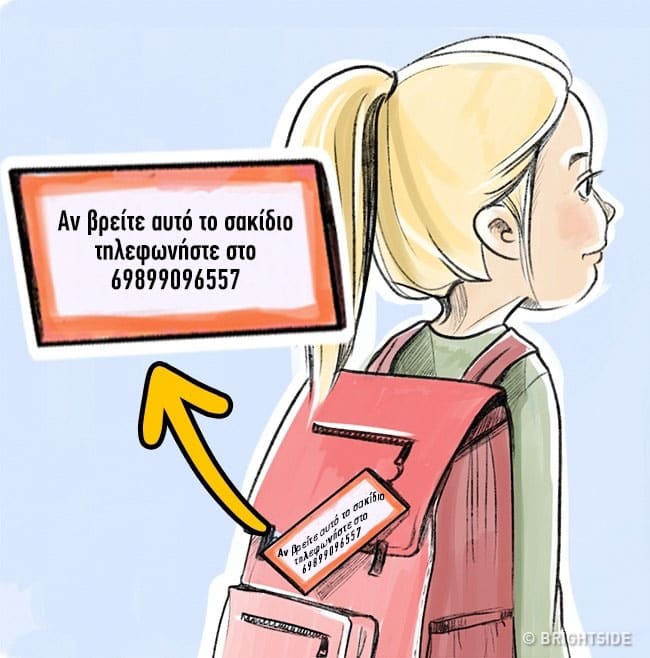
Μην γράφετε το όνομα του παιδιού σας στα προσωπικά του αντικείμενα. Ούτε στο σακίδιό του, ούτε στην τσάντα με το κολατσιό του. Τα πράγματα του παιδιού σας δεν πρέπει να δίνουν στους ξένους πρόσβαση στις προσωπικές του πληροφορίες. Όταν ένας ξένος φωνάζει ένα παιδί με το όνομά του, αμέσως κερδίζει την εμπιστοσύνη του και αυτό μπορεί να οδηγήσει σε επικίνδυνες καταστάσεις.
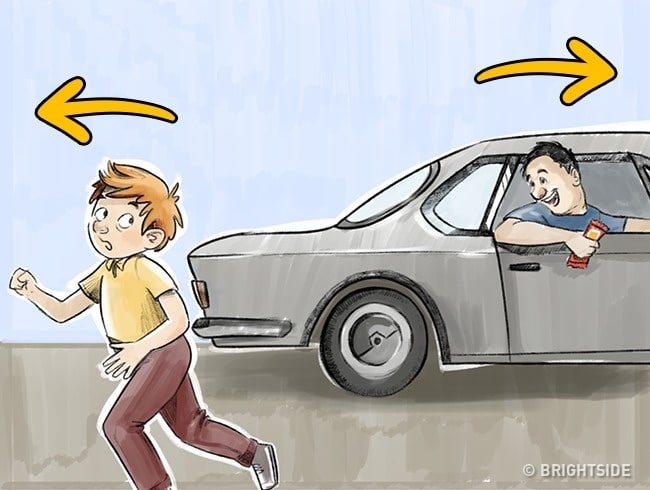
Το να μάθετε στο παιδί σας να μην μπαίνει σε αυτοκίνητα ξένων, είναι ζωτικής σημασίας. Αλλά το παιδί σας πρέπει να μάθει έναν ακόμα κανόνα: αν το πλησιάσει ένα αυτοκίνητο ή το ακολουθεί και προσπαθεί να του τραβήξει την προσοχή, θα πρέπει να τρέξει γρήγορα προς την αντίθετη κατεύθυνση.
We teach our children not to get into cars with strangers, and that's important. But your child should learn one more rule: if a car pulls up near you or starts to follow you with people inside the car attempting to draw your attention, you should run quickly in the direction opposite to the movement of the vehicle. This will help you buy time to call for help.

Αν κάποιος πει στο παιδί σας “Έλα μαζί μου. Θα σε πάω στη μαμά και το μπαμπά”, το πρώτο πράγμα που θα πρέπει να κάνει, είναι να ρωτήσει τον άγνωστο πώς λένε τη μαμά και το μπαμπά και ποιος είναι ο οικογενειακός κωδικός τους. Καλό θα ήταν να βρείτε μια λέξη ασφαλείας, για περιπτώσεις έκτακτης ανάγκης.
If someone says to your child, "Come with me. I'll take you to your mom and dad!" the first thing your little one should do is ask this stranger, "What are my parents' names? And what's our family password?" We advise you to invent with your child a code phrase for emergency situations (for instance, in case you need to ask an acquaintance to collect your child from daycare or school). Use something unexpected (and, therefore, impossible to guess), like "Fluffy Orange."
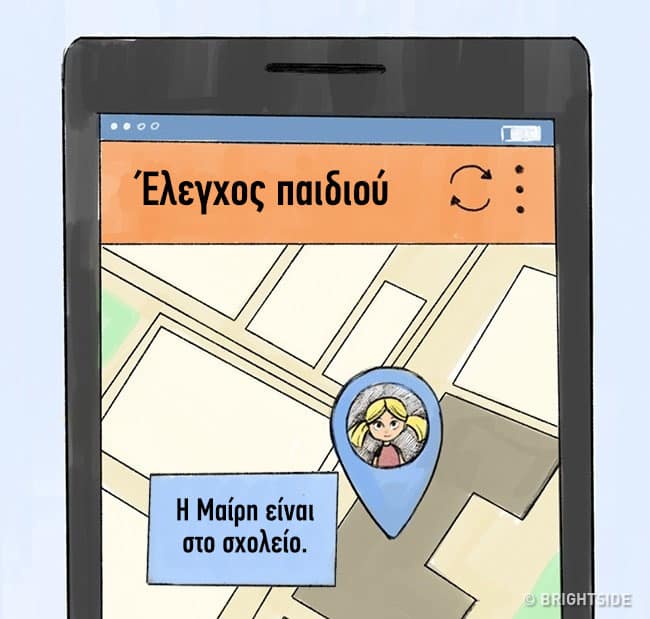
Χάρη στη λειτουργία GPS, τέτοιες εφαρμογές σας επιτρέπουν να παρακολουθείτε την ακριβή τοποθεσία του παιδιού σας και πόση μπαταρία έχει στο κινητό του.
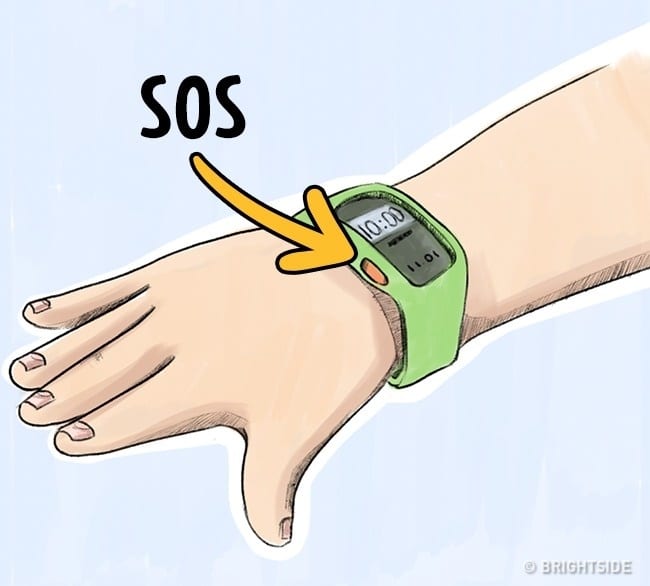

Πείτε στο παιδί σας ότι αν το αρπάξει κάποιος ξένος, θα πρέπει να φωνάξει, να τον δαγκώσει και να τραβήξει την προσοχή των άλλων με οποιονδήποτε τρόπο. Επίσης, θα πρέπει να φωνάζει “Δεν τον ξέρω. Θέλει να με πάρει μακριά.”
Tell your child that, when grabbed by a stranger, it is more than ok to behave "badly": to bite, kick, claw, and try to attract attention at any cost, even if the situation is very scary. Also, your child should keep shouting loudly, "I don't know him/her! He/she wants to take me away!"
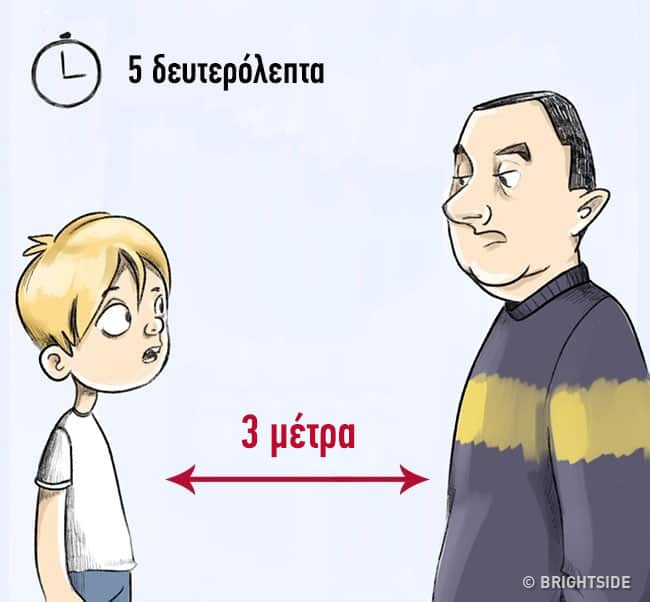
Το παιδί σας θα πρέπει να γνωρίζει ότι δεν είναι υποχρεωμένο να μιλάει σε ξένους, οπότε αν μια συζήτηση διαρκέσει πάνω από 5-7 δευτερόλεπτα, καλό θα ήταν να πάει σε ένα πιο ασφαλές μέρος. Κατά τη διάρκεια της συζήτησης, θα πρέπει να κρατάει μια απόσταση ασφαλείας γύρω στα 2-3 μέτρα. Αν ο ξένος προσπαθήσει να πάει πιο κοντά, το παιδί θα πρέπει να απομακρυνθεί.
Your child should know that he/she is not obliged to talk to strangers, so, if the conversation lasts longer than 5-7 seconds, it's best to leave and head for a safe location. While the conversation lasts, a child should always stand at a distance of 6.5-8 feet away from a stranger; if a stranger tries to come closer, it is important to take a step back. Practice this situation with your child, show him/her what a distance of 6.5 feet looks like, and stress that it should be maintained no matter what.

Μάθετε στο παιδί σας να περιμένει το ασανσέρ με την πλάτη στον τοίχο, ώστε να μπορεί να βλέπει όποιον πλησιάζει. Σε περίπτωση που έρθει κάποιος άγνωστος, θα πρέπει να βρει μια οποιαδήποτε δικαιολογία για να μην μπει στο ασανσέρ. Η καλύτερη επιλογή, είναι να προσποιηθεί ότι ξέχασε κάτι. Αν ο ξένος επιμείνει να μπει στο ασανσέρ μαζί του, το παιδί σας θα πρέπει να πει ευγενικά: “Οι γονείς μου λένε ότι πρέπει να μπαίνω στο ασανσέρ μόνος μου ή με τους γείτονες.”
Teach your child to wait for the elevator with his/her back to the wall so as to be able to see anyone approach. And, if it's a stranger or someone barely familiar, your little one should invent any excuse not to enter the elevator with this person. The best options are to pretend to have forgotten something or to go and check the mailbox. If the person persists in his/her invitations to step into the elevator, your child must politely reply, "My parents say that I should only ride the elevator alone or with our neighbors." Tell your child that if a stranger tries to drag him/her inside the cabin by force or to gag his/her mouth, it is crucially important to fight, scream, and bite until adults come to the rescue.

Πείτε στο παιδί σας ότι αν κάποιος χτυπήσει την πόρτα, αλλά δεν φαίνεται από το μάτι και δεν απαντάει στην ερώτηση “Ποιος είναι”, δεν πρέπει σε καμία περίπτωση να ανοίξει την πόρτα. Επίσης, σε καμία περίπτωση δεν πρέπει να πει στον άγνωστο ότι οι γονείς του λείπουν, ακόμα και αν αυτός ισχυριστεί ότι είναι φίλος των γονιών του.
Explain to your child that if there's a call at the door yet no one can be seen through the peephole and no answer comes to the question "Who's there?" he or she mustn't open the door even the tiniest little bit to see what's going on. Also, a child mustn't let a stranger know that his/her parents are away - not even if the stranger claims to be their friend or says that he/she is a municipal worker. If a stranger is very persistent and starts trying to break in, the child must phone their parents or neighbors at once.
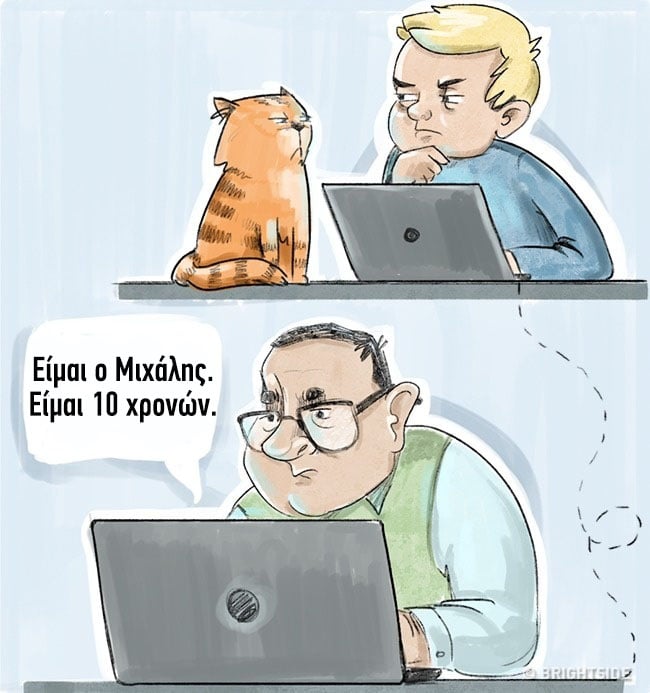
Προειδοποιήστε το παιδί σας ότι στον σημερινό κόσμο, οι εγκληματίες βρίσκουν τα θύματά τους μέσω του διαδικτύου και ότι αν κάποιος του πει πως είναι ο 10χρονος Μιχάλης από την απέναντι πολυκατοικία, δεν είναι σίγουρο ότι λέει την αλήθεια. Επίσης, μάθετε στο παιδί σας να μην αποκαλύπτει σε αγνώστους τη διεύθυνση ή το τηλέφωνο του σπιτιού, ούτε να στέλνει προσωπικές του φωτογραφίες σε ξένους. Τέλος, θα πρέπει πάντα να αρνείται προσκλήσεις από αγνώστους.
Δείτε παρακάτω 10 τρόπους για να βοηθήσετε τα παιδιά σας να μάθουν να συμπεριφέρονται μπροστά σε ξένους. Δείξτε τους τις εικόνες και συζητήστε μαζί τους όλους τους κινδύνους που παραμονεύουν.
Before allowing your child independence, you should take steps to ensure his or her safety.
Today Bright Side will tell you how to teach your child correct behavior around strangers. You should show these illustrations to your little one and discuss all the dangerous situations together.
Today Bright Side will tell you how to teach your child correct behavior around strangers. You should show these illustrations to your little one and discuss all the dangerous situations together.
Μην αποκαλύπτετε το όνομα του παιδιού σας
Not revealing your child's name

Μην γράφετε το όνομα του παιδιού σας στα προσωπικά του αντικείμενα. Ούτε στο σακίδιό του, ούτε στην τσάντα με το κολατσιό του. Τα πράγματα του παιδιού σας δεν πρέπει να δίνουν στους ξένους πρόσβαση στις προσωπικές του πληροφορίες. Όταν ένας ξένος φωνάζει ένα παιδί με το όνομά του, αμέσως κερδίζει την εμπιστοσύνη του και αυτό μπορεί να οδηγήσει σε επικίνδυνες καταστάσεις.
Do not write your child's name on his or her personal belongings; do
not attach a name fob to their backpack; do not put your little one's
name on his or her lunch box or thermos. Your child's things shouldn't
give strangers access to private information. When addressing a child by
their name, an unfamiliar person immediately wins his or her trust,
which can lead to all kinds of dangerous manipulation.
A much better idea is to write your phone number instead - this will prove helpful if anything gets lost or stolen.
A much better idea is to write your phone number instead - this will prove helpful if anything gets lost or stolen.
Τρέχοντας μακριά από αυτοκίνητα, προς την αντίθεση κατεύθυνση
Running away from cars in the opposite direction

Το να μάθετε στο παιδί σας να μην μπαίνει σε αυτοκίνητα ξένων, είναι ζωτικής σημασίας. Αλλά το παιδί σας πρέπει να μάθει έναν ακόμα κανόνα: αν το πλησιάσει ένα αυτοκίνητο ή το ακολουθεί και προσπαθεί να του τραβήξει την προσοχή, θα πρέπει να τρέξει γρήγορα προς την αντίθετη κατεύθυνση.
We teach our children not to get into cars with strangers, and that's important. But your child should learn one more rule: if a car pulls up near you or starts to follow you with people inside the car attempting to draw your attention, you should run quickly in the direction opposite to the movement of the vehicle. This will help you buy time to call for help.
Βρείτε έναν οικογενειακό κωδικό
Inventing a family password

Αν κάποιος πει στο παιδί σας “Έλα μαζί μου. Θα σε πάω στη μαμά και το μπαμπά”, το πρώτο πράγμα που θα πρέπει να κάνει, είναι να ρωτήσει τον άγνωστο πώς λένε τη μαμά και το μπαμπά και ποιος είναι ο οικογενειακός κωδικός τους. Καλό θα ήταν να βρείτε μια λέξη ασφαλείας, για περιπτώσεις έκτακτης ανάγκης.
If someone says to your child, "Come with me. I'll take you to your mom and dad!" the first thing your little one should do is ask this stranger, "What are my parents' names? And what's our family password?" We advise you to invent with your child a code phrase for emergency situations (for instance, in case you need to ask an acquaintance to collect your child from daycare or school). Use something unexpected (and, therefore, impossible to guess), like "Fluffy Orange."
Εγκαταστήστε εφαρμογές εντοπισμού
Installing tracking apps

Χάρη στη λειτουργία GPS, τέτοιες εφαρμογές σας επιτρέπουν να παρακολουθείτε την ακριβή τοποθεσία του παιδιού σας και πόση μπαταρία έχει στο κινητό του.
Ρολόι με κουμπί έκτακτης ανάγκης
Wearing an emergency button watch

Τα γκάντζετ με ενσωματωμένο κουμπί έκτακτης
ανάγκης, έχουν τη μορφή ρολογιού, μπρελόκ, βραχιολιού ή κολιέ. Με μια
ειδική εφαρμογή στα κινητά, οι γονείς μπορούν να παρακολουθούν πάντα την
ακριβή τοποθεσία του παιδιού τους. Αν το παιδί πατήσει το κουμπί, το
σήμα θα πάει στους γονείς ή την αστυνομία.
Gadgets with an inbuilt emergency button come in the form of
watches, key chains, bracelets, or medallions. By means of a special
mobile application, parents can constantly keep an eye on their child's
location. And if the child presses the button, the signal is received by
the parents or the police.
Φωνάζοντας “Δεν τον ξέρω!”
Shouting "I don't know him/her!"

Πείτε στο παιδί σας ότι αν το αρπάξει κάποιος ξένος, θα πρέπει να φωνάξει, να τον δαγκώσει και να τραβήξει την προσοχή των άλλων με οποιονδήποτε τρόπο. Επίσης, θα πρέπει να φωνάζει “Δεν τον ξέρω. Θέλει να με πάρει μακριά.”
Tell your child that, when grabbed by a stranger, it is more than ok to behave "badly": to bite, kick, claw, and try to attract attention at any cost, even if the situation is very scary. Also, your child should keep shouting loudly, "I don't know him/her! He/she wants to take me away!"
Διακοπή συνομιλίας και διατήρηση απόστασης
Breaking off conversations and keeping a distance

Το παιδί σας θα πρέπει να γνωρίζει ότι δεν είναι υποχρεωμένο να μιλάει σε ξένους, οπότε αν μια συζήτηση διαρκέσει πάνω από 5-7 δευτερόλεπτα, καλό θα ήταν να πάει σε ένα πιο ασφαλές μέρος. Κατά τη διάρκεια της συζήτησης, θα πρέπει να κρατάει μια απόσταση ασφαλείας γύρω στα 2-3 μέτρα. Αν ο ξένος προσπαθήσει να πάει πιο κοντά, το παιδί θα πρέπει να απομακρυνθεί.
Your child should know that he/she is not obliged to talk to strangers, so, if the conversation lasts longer than 5-7 seconds, it's best to leave and head for a safe location. While the conversation lasts, a child should always stand at a distance of 6.5-8 feet away from a stranger; if a stranger tries to come closer, it is important to take a step back. Practice this situation with your child, show him/her what a distance of 6.5 feet looks like, and stress that it should be maintained no matter what.
Να μην μπαίνει στο ασανσέρ μαζί με ξένους
Avoid sharing the elevator with strangers

Μάθετε στο παιδί σας να περιμένει το ασανσέρ με την πλάτη στον τοίχο, ώστε να μπορεί να βλέπει όποιον πλησιάζει. Σε περίπτωση που έρθει κάποιος άγνωστος, θα πρέπει να βρει μια οποιαδήποτε δικαιολογία για να μην μπει στο ασανσέρ. Η καλύτερη επιλογή, είναι να προσποιηθεί ότι ξέχασε κάτι. Αν ο ξένος επιμείνει να μπει στο ασανσέρ μαζί του, το παιδί σας θα πρέπει να πει ευγενικά: “Οι γονείς μου λένε ότι πρέπει να μπαίνω στο ασανσέρ μόνος μου ή με τους γείτονες.”
Teach your child to wait for the elevator with his/her back to the wall so as to be able to see anyone approach. And, if it's a stranger or someone barely familiar, your little one should invent any excuse not to enter the elevator with this person. The best options are to pretend to have forgotten something or to go and check the mailbox. If the person persists in his/her invitations to step into the elevator, your child must politely reply, "My parents say that I should only ride the elevator alone or with our neighbors." Tell your child that if a stranger tries to drag him/her inside the cabin by force or to gag his/her mouth, it is crucially important to fight, scream, and bite until adults come to the rescue.
Να μην λέει στους ξένους ότι οι γονείς του λείπουν
Not letting strangers know that their parents are away

Πείτε στο παιδί σας ότι αν κάποιος χτυπήσει την πόρτα, αλλά δεν φαίνεται από το μάτι και δεν απαντάει στην ερώτηση “Ποιος είναι”, δεν πρέπει σε καμία περίπτωση να ανοίξει την πόρτα. Επίσης, σε καμία περίπτωση δεν πρέπει να πει στον άγνωστο ότι οι γονείς του λείπουν, ακόμα και αν αυτός ισχυριστεί ότι είναι φίλος των γονιών του.
Explain to your child that if there's a call at the door yet no one can be seen through the peephole and no answer comes to the question "Who's there?" he or she mustn't open the door even the tiniest little bit to see what's going on. Also, a child mustn't let a stranger know that his/her parents are away - not even if the stranger claims to be their friend or says that he/she is a municipal worker. If a stranger is very persistent and starts trying to break in, the child must phone their parents or neighbors at once.
Πρέπει να αποφεύγει να συναντάει προσωπικά φίλους από το διαδίκτυο
Avoiding meeting online friends in person

Προειδοποιήστε το παιδί σας ότι στον σημερινό κόσμο, οι εγκληματίες βρίσκουν τα θύματά τους μέσω του διαδικτύου και ότι αν κάποιος του πει πως είναι ο 10χρονος Μιχάλης από την απέναντι πολυκατοικία, δεν είναι σίγουρο ότι λέει την αλήθεια. Επίσης, μάθετε στο παιδί σας να μην αποκαλύπτει σε αγνώστους τη διεύθυνση ή το τηλέφωνο του σπιτιού, ούτε να στέλνει προσωπικές του φωτογραφίες σε ξένους. Τέλος, θα πρέπει πάντα να αρνείται προσκλήσεις από αγνώστους.
Warn your child that, in today's world, criminals can find their
prey via the Internet and that if someone online says he's "Mike from
next door," this person might not necessarily be the 10-year-old boy he
claims to be. Innocuous online chat can make us vulnerable to dangerous
individuals. Your child must remember never to tell strangers, not even
children, his/her phone number, address, or name. Nor should your little
one send personal photos to online pals or tell them when and where he
or she likes to hang out. And your child should always decline
invitations to meet in person.
Illustrated by Natalia Popova for BrightSide.me
Κυριακή 14 Ιουνίου 2020
Από ποιους μπορείτε να πάρετε και σε ποιους μπορείτε να δώσετε αίμα

Η ομάδα αίματος κάθε ανθρώπου καθορίζεται από την παρουσία ή την απουσία συγκεκριμένων αντιγόνων, δηλαδή ουσιών που πυροδοτούν την αντίδραση του ανοσοποιητικού με αποτέλεσμα αυτό να απελευθερώνει αντισώματα.
How Blood Type Is Determined And Why You Need To Know
Blood types are determined by the presence or absence of certain
antigens – substances that can trigger an immune response if they are
foreign to the body. Since some antigens can trigger a patient's immune
system to attack the transfused blood, safe blood transfusions depend
on careful blood typing and cross-matching. Do you know what blood type is safe for you if you need a transfusion?
There are four major blood groups determined by the presence or
absence of two antigens – A and B – on the surface of red blood cells.
In addition to the A and B antigens, there is a protein called the Rh
factor, which can be either present (+) or absent (–), creating the 8
most common blood types (A+, A-, B+, B-, O+, O-, AB+, AB-).
Η κατηγοριοποίηση ΑΒΟ
Οι ομάδες αίματος είναι συνολικά οκτώ και αποτελούν υποκατηγορίες των τεσσάρων κύριων ομάδων του συστήματος ΑΒΟ (A, B, AB ή O). Αυτές οι τέσσερις ομάδες καθορίζονται από την παρουσία ή την απουσία δύο βασικών αντιγόνων (Α, Β) στην επιφάνεια των ερυθρών αιμοσφαιρίων, των κυττάρων που μεταφέρουν το οξυγόνο, και ταυτόχρονα από την παρουσία ή απουσία αντισωμάτων στο πλάσμα, δηλαδή το υγρό συστατικό του αίματος:- Ομάδα Α: Υπάρχει μόνο το αντιγόνο Α στην επιφάνεια των ερυθρών αιμοσφαιρίων (και το Β αντίσωμα στο πλάσμα του αίματος).
- Ομάδα Β: Υπάρχει μόνο το αντιγόνο Β στην επιφάνεια των ερυθρών αιμοσφαιρίων (και το Α αντίσωμα στο πλάσμα του αίματος).
- Ομάδα ΑΒ: Υπάρχει και το αντιγόνο Α και το αντιγόνο Β στην επιφάνεια των ερυθρών αιμοσφαιρίων (και ούτε το αντιγόνο Α ούτε το αντιγόνο Β στο πλάσμα του αίματος).
- Ομάδα Ο: Δεν υπάρχει ούτε το αντιγόνο Α ούτε το αντιγόνο Β στην επιφάνεια των ερυθρών αιμοσφαιρίων (και τόσο το αντιγόνο Α όσο και το αντιγόνο Β στο πλάσμα του αίματος).
Πώς καθορίζεται η ομάδα αίματος
Όπως και το χρώμα των ματιών και πολλά άλλα χαρακτηριστικά, η ομάδα αίματος καθορίζεται από τα γονίδια που κληροδοτούν οι γονείς. Ανάλογα με τη «μείξη» των ομάδων αίματος των δύο γονέων, στον παρακάτω πίνακα παρουσιάζεται πώς προκύπτει η ομάδα αίματος του παιδιού.
Συμβατότητα ομάδων αίματος
Σε περίπτωση μετάγγισης αίματος πρέπει να εξασφαλιστεί ότι το αίμα του δότη είναι συμβατό με αυτό του αποδέκτη, δηλαδή ότι το αίμα του πρώτου δεν περιέχει αντιγόνα που θα πυροδοτήσουν την ανοσολογική αντίδραση στον δεύτερο.Η συμβατότητα μεταξύ των διαφόρων ομάδων αίματος παρουσιάζεται σχηματικά στην παρακάτω εικόνα.

- Η ομάδα Ο- μπορεί να δώσει αίμα σε οποιαδήποτε άλλη, γι’ αυτό ονομάζεται πανδότης.
- Η ομάδα Α μπορεί να δώσει αίμα στην Α και στην ΑΒ.
- Η ομάδα Β μπορεί να δώσει αίμα στην B και στην ΑΒ.
- Η ομάδα ΑΒ μπορεί να δώσει μόνο στην ΑΒ, αλλά να λάβει από οποιαδήποτε άλλη, γι’ αυτό ονομάζεται πανδέκτης.
- Όσο για το σύστημα ρέζους, οι ομάδες Rh θετικό δίνουν σε ομάδες Rh θετικό και οι ομάδες Rh αρνητικό δίνουν σε ομάδες Rh αρνητικό.
- Η πιο κοινή ομάδα αίματος είναι η O+ και η πιο σπάνια η AB-.
-
There are very specific ways in which blood types must be matched for a safe transfusion. The right blood transfusion can mean the difference between life and death.Every 2 seconds someone in the US needs a blood transfusion.Use the interactive graphic below to learn more about matching blood types for transfusions.
Also, Rh-negative blood is given to Rh-negative patients, and Rh-positive or Rh-negative blood may be given to Rh-positive patients. The rules for plasma are the reverse.
- The universal red cell donor has Type O negative blood.
- The universal plasma donor has Type AB blood.
- https://www.redcrossblood.org/donate-blood/blood-types.html
Εγγραφή σε:
Αναρτήσεις (Atom)













